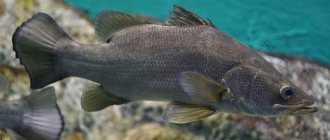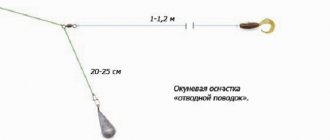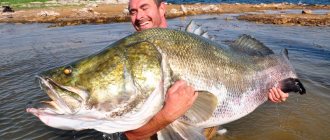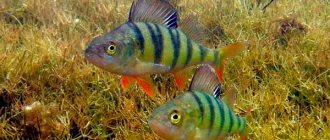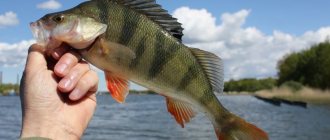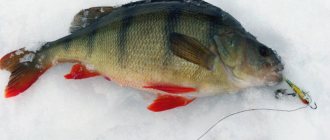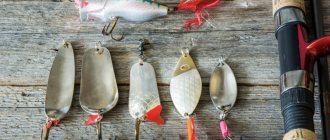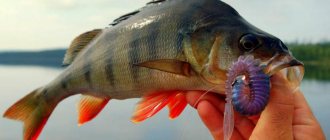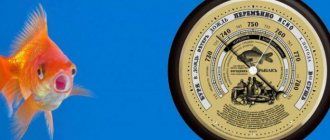Largemouth bass (bass) is a fish of the family Centrarchidae, order Perciformes. As with some other fish that are “native” to the “New World,” there is some confusion in the names. The word bass is English and is translated as perch. But there is one peculiarity here. Americans most often use the word bass to describe largemouth bass or trout bass, as well as similar fish of the black perch genus. The same now applies to Russian fishermen. This is primarily due to the fact that largemouth bass is successfully distributed in many regions of the world, where it becomes an excellent target for recreational fishermen, as well as during various competitions.
This species is characterized by a dense, somewhat elongated body. Body height in proportion to length is 1/3. With age, the fish's body becomes taller. The body, compressed from the sides, like part of the head, is covered with medium-sized scales. The upperparts are dark, olive green. The head is large, the line of the mouth extends far beyond the posterior border of the eyes. The eyes are large and predatory. There are slanting, dark stripes on the head. On the sides of the body there are black or dark spots, forming a stripe along the entire body. Old individuals are darker in color. The lower jaw is longer than the upper. The dorsal fin is divided by a notch. The relatively small anterior part has 9-10 spiny rays. The back of the fin is soft, with one hard ray. The anal fin also has spiny rays. The powerful caudal peduncle is clearly defined, with a notched fin. Largemouth bass are the largest black bass, with females being larger than males. Dimensions can reach a length of up to 75 cm and a weight of more than 11 kg.
Bass is a resident of stagnant or slow-flowing, shallow reservoirs. An important feature is its heat-loving nature, which creates major problems with breeding in Russian reservoirs. Is an ambush predator. Prefers to be in thickets of vegetation or in snags. The main depth range is up to 6 m. It often uses uneven coastal topography, caves or burrows for ambushes. In this case, the fish primarily relies on visual orientation. The predator has no special food preferences. Large individuals can even attack waterfowl. These predators often hunt for various amphibians, crustaceans and small mammals. They grow very quickly, with females especially excelling in size. In reservoirs where vegetation is poorly represented, it leads a more active lifestyle, but is quite aggressive and can squeeze out other species.
Fishing methods
Bass is a kind of “brand” in the world of sport fishing. Along with the New World, in regions where largemouth bass farming has been successful, it has become an important commercial fishery. Specialized competitions for catching this fish are held among sports fishermen. North Americans are the “trend setters”; there is a whole industry dedicated to this type of fishing. Now this trend in sports fishing has captured the whole world. Commercial breeding for “bass fishing” is actively developing in southern Europe and North Africa. Bass fishing has completely occupied Japan. The Russian Bass League has existed for quite a long time. The main type of fishing for largemouth bass is fishing with artificial bait using spinning and casting rods. Currently, sport and amateur fly fishing for bass is actively developing. Largemouth bass, like other active predators, respond well to natural baits. For this you can use live bait, frogs, large worms, etc.
Fishing with spinning rod
The American Bass Sports League has greatly influenced the fishing style and choice of gear among amateur spinners. The widespread use of lightweight baitcasting reels for this type of fishing has become a powerful impetus for the creation of a large number of casting gear. As a result, multiplier reels have now been created with which you can cast the lightest baits. Bass fishing tactics in traditional reservoirs do not require ultra-long casts; rather, accuracy and high sensitivity of the gear are important. The choice of gear for catching this fish is built on this basis. Most often, these are not long rods with a fast action, which make it possible to clearly hook and quickly fish out of overgrown areas of the reservoir. But this recommendation is not always suitable for fishing in artificial reservoirs in Africa and southern Europe, where bass are actively bred for commercial purposes.
The water area, as well as the coastline of such reservoirs, is quite deserted, so the use of longer, more powerful rods is quite appropriate here. In any case, using ultra-light, slow action blanks is not the best choice for bass fishing. Using baitcasting reels requires a certain skill and is not always justified for beginners. Moreover, with a little skill, using inertia-free reels, which are more familiar to Europeans, does not create any problems when catching bass. Multiplier reels are more demanding in preparing gear and choosing bait. However, casting itself requires additional training. Otherwise, fishing in a distant body of water during the “precious” time of a short vacation can turn into an endless untangling of “beards” and a search for the optimal weight of bait for casting. From the standpoint of the best sensitivity of the gear, the most correct solution would be to use braided cords that create maximum contact with the fish at the moment of biting. The use of fluorocarbon lines, like other monofilament, as the main winding of the reel is also quite justified. Recently, fluorocarbon has been most popular among athletes and amateur fishermen as leaders or shock leaders. It is worth noting that bass is often very picky about the selection of baits, fishing depth, etc. This requires certain knowledge of the conditions of the reservoir and the life rhythms of the fished object.
Fly fishing
No less interesting is catching bass with fly fishing gear. Taking into account the fact that the main habitat of this fish is the coastal or shallow part of the reservoir, fishing can be carried out both from the shore and from boats. Fishing mostly takes place with large imitations of various animals, including surface baits. One-handed rods are most often used, starting from class 6. Well-known cord manufacturers make entire series of specialized products. The main difference between these models is the short head, but nowadays a large arsenal of cords and shooting heads fits this type. The most popular and easy to learn cords include the “Ambush Triangle Taper” or “Triangle Taper Bass” from the manufacturer Royal Wulff.
Largemouth Bass
Largemouth Bass , or Largemouth Bass, or Largemouth Bass, is one of the species of bass belonging to the genus Black Bass. It is valued by fishermen all over the world for its lively character and active behavior when fishing. The natural habitat of the Largemouth Bass is North America, however, due to the great popularity of the fish as an object of recreational fishing, the Largemouth Bass was introduced into many reservoirs around the world and today is found in Southern Europe (Spain, Italy), Japan, South Africa, New Zealand and others countries.
Description: The body of Largemouth Bass is olive green with dark spots that form an often jagged horizontal stripe along the lateral line on either side of the body. A distinctive feature of the Largemouth Bass is its large mouth, the angle of which extends beyond the edge of the eye, while the lower jaw is longer than the upper.
Size: Largemouth Bass is the largest species of the Black Bass genus, reaching a maximum total length of 75 cm and a weight of over 11 kg. However, the catches are dominated by individuals weighing from 0.4 to 1.8 kg. A bass weighing 5 pounds (2.265 kg) is considered very large.
Habitat: Largemouth Bass inhabits mainly lakes, ponds, reservoirs, medium and large lowland rivers. The high level of adaptability allows Bass to also survive in drainage ditches, shallow streams, swamps and canals. Largemouth Bass is a warm-water fish. The ideal water temperature for Bass is between 18 and 29 degrees Celsius, but it can live in much colder water. Water quality is not decisive for Bass - individuals are found with equal frequency in both muddy and clear water. Largemouth Bass prefer to stay in areas with abundant aquatic vegetation without or with little current. The favorite habitats of the Largemouth Bass are shelters of various kinds, such as the leaves of water lilies, windows among aquatic vegetation, various snags, flooded trees and stumps, underwater rocks and ridges, from where it makes throws as if from an ambush for small fish or insects swimming past. Largemouth Bass primarily live in shallow areas (0.5 to 2 meters). But if there are not enough places for shelter in the reservoir, Bass stays at great depths in areas with uneven bottoms, holes and edges.
Lifestyle and habits: Largemouth Bass in its lifestyle resembles our small pike and is predominantly a sedentary fish, preferring to stay in its chosen habitat for a long period of time. Migrations mainly occur with changing weather conditions and are seasonal. In early spring, Largemouth Bass leave their winter resting places in deep areas and move to shallow waters near spawning grounds. Individuals of Bass stay here throughout the spawning season, sometimes moving to the nearest depths during a sharp cold snap. After the spawning period ends, most Bass fish remain in these same shallow water areas until the water temperature reaches 21-23 degrees Celsius. After which the Bass moves to deeper summer camps, making forays into nearby shallow waters in the mornings and evenings, as well as at night. In the fall, Bass returns to the shallow “spring” areas, and with the onset of prolonged cold weather, it moves back to the deep winter sites.
Diet: Largemouth Bass are a generalist predator. Its diet includes small fish, snails, crayfish, insects, shrimp, amphipods, frogs, snakes, salamanders, small waterfowl, rodents and even baby alligators.
Sport Fishing: Largemouth Bass is one of the most popular sport fish in the world and probably the most popular fish in the United States. The annual Bassmaster Classic bass fishing competition in America can only be compared in popularity to the Super Bowl. They are attended by thousands of spectators, and millions watch the battle of the best hundred US fishermen live. Moreover, the prize for first place in 2014 was $300,000.
Anglers most often catch Largemouth Bass using spinning gear and artificial lures. These are mainly silicone baits: vibrotails, twisters, worms, and little-known octopuses (Tubes). A very popular bait among American fishermen is one created specifically for Bass fishing, called the Bass Jig. Fishing for Largemouth Bass on topwater lures such as poppers and crawlers, as well as topwater artificial frogs, is incredibly exciting. When fishing with a float, animal baits such as worms, small fish, frogs and crayfish are used.
Distribution in the United States: The original range of Largemouth Bass at the beginning of the last century was limited to the Eastern United States, but today it is found everywhere throughout the country. However, the largest populations of Largemouth Bass live in the reservoirs of the Southeastern United States. Largemouth Bass is the “State Fish” in Alabama, Florida, Georgia, Tennessee and Mississippi.
Share
- Smallmouth Bass
- Spotted Bass
- Peacock Bass
- Striped Bass
Lures
A huge number of baits are used to catch bass. As already mentioned, the fish is quite aggressive and voracious. She hunts in all layers of water. When fishing, a variety of fishing techniques are used. Therefore, it is possible to use almost the entire possible arsenal of lures of a modern spinning rod and fly fisherman. Depending on the conditions of the reservoir, spinners can use various lures, spinner baits, voluminous baits: bladed and bladeless, silicone imitations, etc. Bass can be caught very well using natural, live baits and using even the simplest float or live bait equipment. For fly fishermen, the choice of lures comes down to large, floating and sinking imitations. Here we should not forget that half the success is the correct tactics and fishing technique, taking into account the fact that in most cases largemouth bass relies on vision to select a prey. When choosing a specific bait, first of all, it is worth understanding in which layer of water the active predator is located.
Black-Bass or black perch
Black-Bass or black perch was brought to us from North America. Its homeland is the St. Lawrence and Mississippi rivers and lakes. This fish, artificially grown, was distributed throughout all waterways of the United States. We call black bass largemouth and trout perch.
What does a perch look like?
The body is elongated, depending on the age of the fish, it can be compressed at the sides. Colored in light olive tones, with very dark, even black spots. There is a jagged horizontal stripe on both sides of the body. The belly is white with a pink-silver tint. The gill covers are strewn with dark spots.
A large head with oblique dark stripes, a large retractable mouth, the lower jaw of which is larger than the upper. This gives the perch a menacing appearance. There are about seventy ctenoid scales on the sides. These are translucent round plates with jagged edges. The scales themselves are small and smooth, dark green in color.
The dorsal fin has a deep groove separating it. In this case, the front part of the fin is smaller than the second. In the anal fin area there are three spiny and up to 11 soft rays. The fins on the belly are not connected and are parallel to the pectoral fins. The powerful tail has a cutout with rounded blades.
The maximum length of black perch is about 75-90 centimeters, and the weight, according to unofficial data, can be close to 11.5 kilograms. Females are larger. These are the largest bass belonging to the black grouper family.
Where does perch live?
The predator loves calm and quiet bodies of water with a vegetative bottom topography. It can be found in deep bays and oxbow lakes. There he hides in ambush and awaits his prey. Juveniles live in smaller areas. In our country, this type of perch can only be found in the Don and Kuban River. In other regions of our country, this species has practically not taken root. Perch lives about 16.5 years.
What does it eat?
Adult perch prefers to feed on young fish, crayfish, as well as frogs and snakes. The young feed mainly on small fish, amphipods, and insects. In their homeland, these perches can even prey on young crocodiles, small birds, and they can even be tempted by bats. Behind them, a large-mouthed predator jumps high out of the reservoir and overtakes the prey.
Also interesting: Reelless for perch
Because of its large mouth, bass can swallow prey that reaches up to a third of its entire body length.
Being an ambush predator, bass loves dense aquatic vegetation, but if there is not enough of it, it stimulates the activity of the perch. Sometimes such predator activity leads to the displacement of other species from the body of water favored by perch.
How Bass reproduce
Schwarzbarsch, as the Germans call it, or black perch, and the male clears a pre-selected place among large pebbles or sand for spawning. Sweeping away silt and dirt, it forms a hole with its tail.
The result is a cleared area with a diameter of about a meter. Then the future father invites the “lady of his heart” to his nest for marital pleasures. The female lays up to four thousand eggs, and the male, after fertilization, watches over his offspring and protects them until the egg turns into a small fish.
How they catch
Perch hunting times are periods of open water. This is early spring, summer, autumn. When the first frosts appear, fishing for predators stops, as bass loves warmer water. This perch is accustomed to delicate baits with a very slow retrieve. He bites regularly and his bites are quite powerful.
The most acceptable type of fishing is spinning. This could be the shore of a reservoir, or a boat anchored near the perch’s feeding area. You must have a strong three-meter fishing rod. It will be indispensable in those places where there are obstacles such as aquatic vegetation, etc., where you will have to make frequent and strong twitches to free a caught spoon. In order to pull fish ashore you will also need reliable tackle.
The reel must be powerful, have an average winding speed, and have a spool designed for nylon fishing line with a thickness of up to 0.3 millimeters. The fishing line must withstand a sharp jerk of the fish and have high wear resistance.
Also interesting: Finding perch in winter
Lures for perch
Among the large variety of spinners offered by supermarkets, the most popular for catching black perch are diving and floating wobblers from Rapala and poppers ; surface-running wobblers that imitate the movements of a fish or frog. This bait makes splashes and splashes as it moves away from the predator. They are used in those reservoirs where there is densely growing aquatic vegetation.
You can try catching a predator with a fly. It enjoys feeding on large insects, small mammals, and other such creatures. This means that their imitation can confuse the perch, and he will be tempted by the bait you offer. Various fancy baits made from balsa wood are especially catchy. They are brightly colored and decorated with feathers and threads.
Fly fishing involves, as described above, the use of a powerful three-meter carbon fiber rod with a No. 8 fly line, which is designed to use lures for largemouth predators. The equipment must be mounted with a metal leash 0.22 millimeters wide. Fishing with fancy bait is carried out by casting the bait into free spaces in aquatic vegetation. In these places, black perch waits for its prey, lying in ambush.
Before fishing, you need to study the habits of perch, since it behaves differently at different times of the year. For example, in the spring, perch can be found in shallow water near the shore, and in the summer it can be on the surface.
The fighting qualities of bass have won sporting interest among professionals and constantly keep anglers in a wonderful and pleasant tension, and this gives fishing an emotional boost.
Author: N.K
Fishing places and habitat
The natural habitat of largemouth bass is various bodies of water in North America: from the Great Lakes to the Mississippi Basin and more. Artificially distributed in many reservoirs around the world. For Europeans, the most interesting are the reservoirs of Spain and Portugal. Russian fishermen are actively developing the “bass” reservoirs of Cyprus. Largemouth bass are actively farmed in Croatia. Residents of the eastern regions of Russia should not forget about the popularity of bass in Japan. There have been attempts to acclimatize this species in Russian reservoirs. Similar experiments were carried out at reservoirs near Moscow and in the south of the country. Currently, small populations have survived in the Kuban River, on the Don and on Lake Abrau (Krasnodar Territory), etc. Puberty occurs within 3-5 years.
